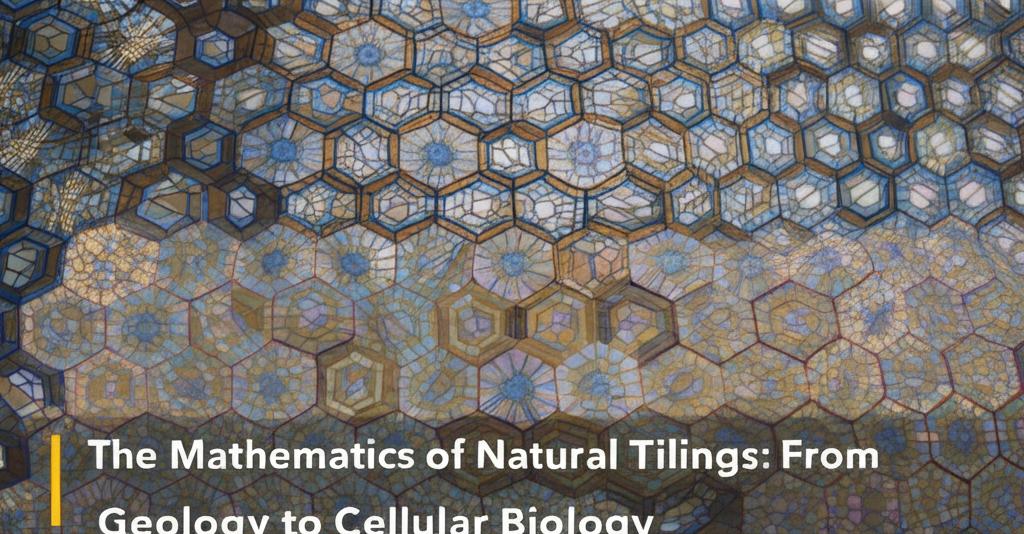Nature's intricate patterns, from the cracked earth to the organization of cells, are not random but often follow precise mathematical rules. The study of natural tilings, or how shapes fit together to fill space, reveals the underlying mathematical principles governing the formation and structure of diverse natural phenomena. This exploration spans the macroscopic world of geology to the microscopic realm of cellular biology, offering a unified mathematical lens through which to understand these processes.
A central concept in understanding natural tilings is tessellation, the process of covering a surface with one or more geometric shapes, called tiles, with no overlaps and no gaps. While human-made designs often employ regular, repeating patterns, nature frequently showcases more complex and seemingly irregular arrangements.
In geology, mathematical principles of tiling are evident in various formations. For example, the columnar jointing in basalt, often forming hexagonal pillars like those at the Giant's Causeway, can be understood through processes of cooling and contraction that naturally favor energy-minimizing, polygonal structures. Polygonal and polyhedral tessellations, with their flat faces and sharp corners, have been successful models for describing geological phenomena ranging from crack networks to convection cells. The study of rock fragments, which can often be modeled as polyhedra, reflects these geometric underpinnings. Furthermore, geomathematics leverages tools like probability theory, stochastic processes, and fractal geometry to model and analyze complex geological structures and the spatial variability inherent in geological datasets. Mathematical geology, as a discipline, focuses on constructing and analyzing mathematical models of geological events, recognizing that many geological attributes behave as random variables.
Voronoi tessellations (also known as Dirichlet tessellations) provide a powerful mathematical tool for analyzing spatial patterns in geology and other fields. Given a set of points (seeds), a Voronoi diagram divides space into regions, or cells, where each cell contains all locations closer to its defining seed than to any other seed. This concept has been applied to diverse geological applications, including the study of earthquake epicenters and the modeling of crystal growth. The dual of the Voronoi diagram, the Delaunay triangulation, connects points (sites) if their Voronoi cells share a boundary, forming a network of triangles. This triangulation has the property that the circumcircle of any triangle in the network is "empty," meaning it contains no other sites. Delaunay structures are valuable for representing surfaces and understanding neighbor relations among points in space.In cellular biology, the principles of tiling are equally fundamental. The arrangement of cells in tissues often resembles a mosaic. For instance, the epithelial cells that line surfaces in organisms, the compound eyes of insects, and even structures within the brain exhibit tiling patterns. These biological patterns are often functionally important. For example, the retina in the human eye is composed of cells arranged like a mosaic to process our visual field. While biochemical interactions have long been studied for their role in pattern formation, mechanical interactions between cells are also crucial and can be understood through tiling theory.
Recent mathematical advancements have shed new light on the types of shapes nature employs. While classical geometry often focuses on shapes with sharp corners and flat faces, natural structures frequently exhibit curved edges and surfaces. Mathematicians have recently identified a new class of shapes called "soft cells" that can tile space without sharp corners. These "ideal soft shapes" are found abundantly in nature, from seashells to muscle cells, and help explain how biological tissues achieve complex geometries. In two dimensions, these soft cells often have curved boundaries with only two corners, appearing in patterns like muscle cells and even the layers of an onion bulb. In three dimensions, these soft cells can become more complex, potentially having no corners at all. This concept of "soft tilings" suggests that minimizing sharp corners may be a guiding principle in the evolution of natural tilings.
The study of aperiodic tilings, patterns that fill space but do not repeat in a regular way, also offers insights. The recent discovery of "einstein tiles" – single shapes that can tile a plane aperiodically – has significant implications. While a direct link to widespread natural occurrences of strict aperiodic monotiles is still an area of research, molecular-scale self-assembly has shown that hydrocarbon molecules can naturally form irregular, non-repeating patterns, akin to a molecular "einstein." This suggests that principles of aperiodic tiling could be relevant in understanding the formation of quasicrystals and other complex materials.
The transition between different tiling patterns, such as hexagonal and tetragonal arrangements observed in biological systems like the compound eyes of some insects, is another active area of research. Mathematical models incorporating adhesion, repulsion, and attraction between cells are being developed to understand these dynamic pattern formations.
In essence, the mathematics of natural tilings provides a framework for understanding how fundamental geometric and physical principles drive the emergence of order and pattern across vastly different scales and systems in the natural world. From the rigid structures of cooled lava to the dynamic organization of living cells, mathematical concepts like tessellation, Voronoi diagrams, and the emerging understanding of soft and aperiodic tilings offer powerful tools for deciphering nature's intricate designs.

